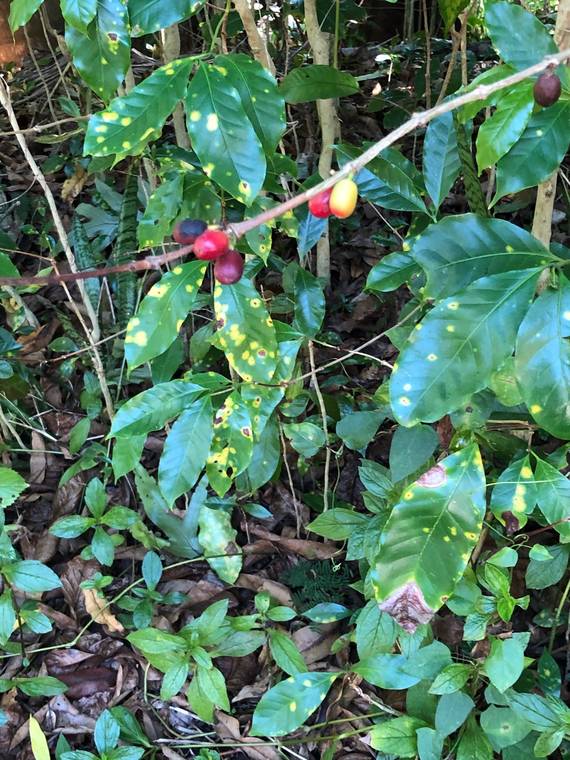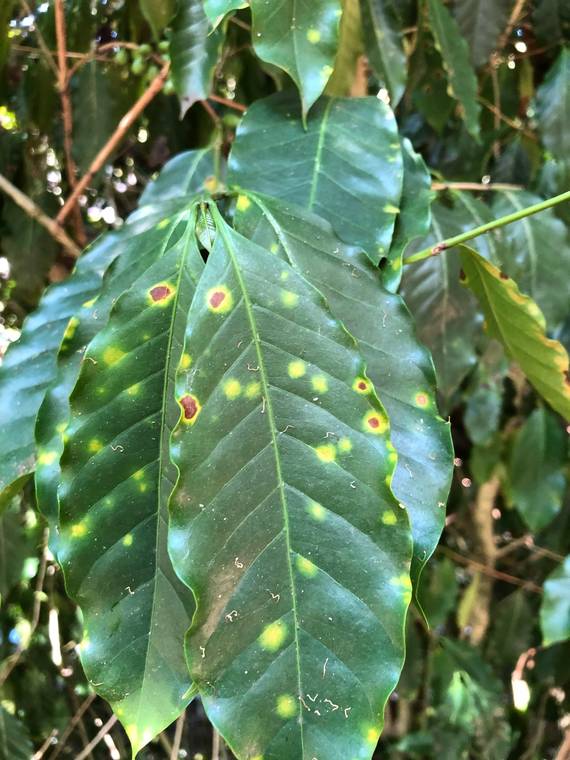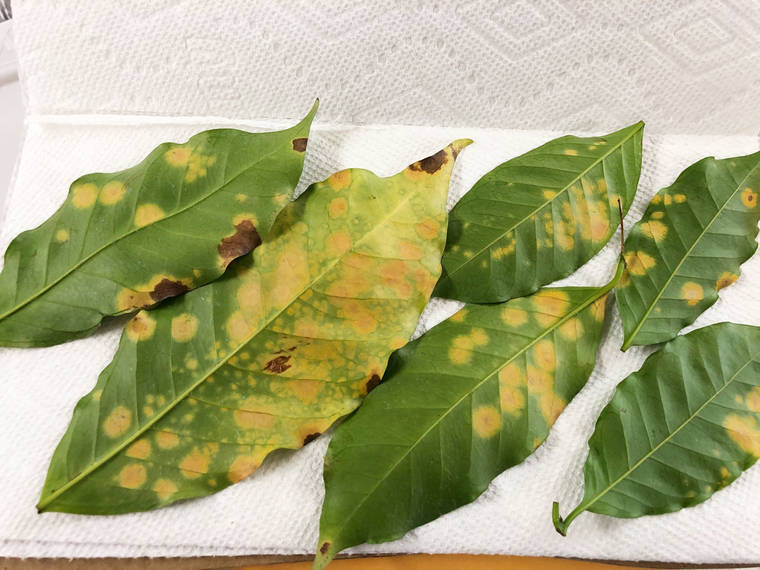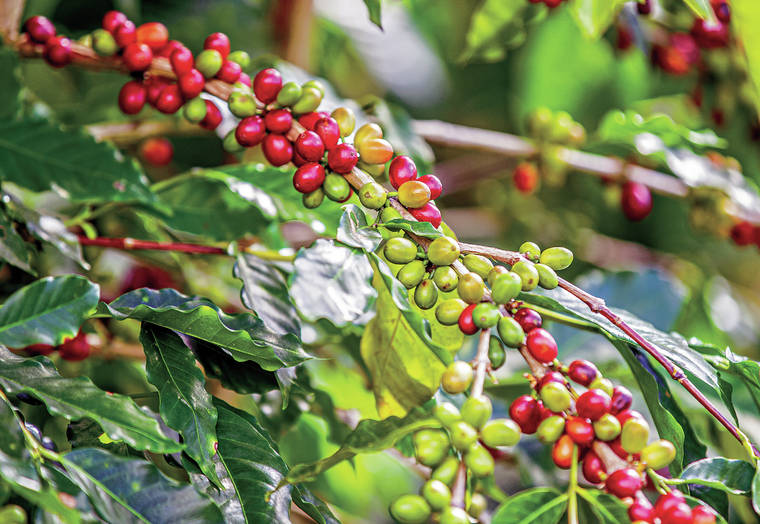Coffee leaf rust confirmed in Kona: Leaders creating plans to fight new pest

HDOA

HDOA

HDOA

The coffee trees at Heavenly Hawaiian Coffee Farm in Holualoa extend over a panoramic view of the Pacific. (Tom Linder/West Hawaii Today)

Coffee berries at Heavenly Hawaiian Coffee Farm grow as they await being picked. (Tom Linder/West Hawaii Today)
Since the discovery of coffee leaf rust was confirmed on Hawaii Island in October, the coffee community — from individual farmers to the state’s Department of Agriculture — has been working to find ways to combat the spread of the pest.
Since the discovery of coffee leaf rust was confirmed on Hawaii Island in October, the coffee community — from individual farmers to the state’s Department of Agriculture — has been working to find ways to combat the spread of the pest.
Now, the fungus has been confirmed in the Holualoa area. The state Board of Agriculture’s chairperson Phyllis Shimabukuro-Geiser expressed the department’s intentions to soon implement rules designed to slow the spread to other islands. The Advisory Committee on Plant and Animals has scheduled a meeting for this Friday at 1:30 p.m., during which an interim rule restricting the movement of coffee plants will be considered.
“Coffee is one of Hawaii’s signature crops, of which production was estimated to be $54.3 million in 2019,” said Shimabukuro-Geiser. “As surveys continue across the state, the Hawaii Department of Agriculture is preparing to establish interim rules that will hopefully prevent the spread of the fungus to uninfested islands.”
In Kona, Colehour Bondera — president of the Kona Coffee Farmers Association — highlighted three steps he hopes farmers will take to help slow the spread within the Big Island.
“People need to really pay attention to any signs of the rust on their farms by touring and paying attention to their leaves and their farms intimately,” said Bondera. “The second most important thing that I personally resonate with the most is that coffee trees can fight off being infected by the rust if they’re in very good health. … Providing the trees with whatever and as much nutrition is as viable is critical. The third thing: a lot of the entities are speaking out about pretty strongly is a lot of copper-based products that you can spray onto the leaves of the trees.”
Since coffee leaf rust (CLR) spreads more easily than other pests like the coffee berry borer, a cooperative effort from the entire community will likely be necessary to manage the problem. Loss estimates range from 30% to 80% on yields if left unchecked, highlighting the seriousness of the new threat.
“We cannot manage this all on our own; we’re going to have to manage it together,” said Ray Taggart, farm manager at Heavenly Hawaiian Coffee Farm, which has not been affected by CLR. “My biggest concern going forward is a neighboring farm nearby that doesn’t do anything or doesn’t have the ability to do anything. If they become inundated with it, the breeze is going to bring it right over.”
Bondera echoed this concern, stating his intentions to personally lobby the Department of Agriculture and state Legislature to ensure all farms are able to take the necessary measures in combating CLR.
“Whether it’s coming from state or federal funds, I can’t say; I don’t know,” said Bondera. “But in order to get people to take on an added expense that’s unplanned and unanticipated, I think working with those entities to try to figure out how to get some kind of subsidization in place would be extraordinarily useful.”
“The state and the government need to decide whether or not this culture, the coffee culture, is something they want to preserve for Hawaii,” said Bill Myers, general manager of the Heavenly Hawaiian Coffee Farm. “I think it’s something that makes Hawaii distinctive; if you want to pivot away from tourism, this is one of the major pivots that exists today.”
Myers credited the state with its swiftness in reacting once CLR was detected in Hawaii. A wealth of information has been spread to farmers in recent weeks, ensuring as many people as possible have the latest knowledge. One aspect he hopes the government will still take, however, is to approve treatments that are currently allowed for other crops, but not coffee.
“There are a couple of fungicides that are used all over the world and are approved for use in the United States with other products, but aren’t approved for use with coffee,” said Myers. “If it’s OK to use on bananas, it ought to be OK to use on coffee, unless there’s a really good reason.”
No single treatment is likely to be a complete remedy moving forward. Both Taggart and Myers iterated how important it will be that farmers take care of their trees in every way possible in the future, and to ask for help if it’s needed. The community cooperation that will be necessary in the coming weeks, months and years leads into Bondera’s overarching view of addressing the problem, one that will see systematic changes throughout the industry.
“There isn’t one simple answer to this problem; there are no solutions or answers to it anywhere in the world,” said Bondera. “We need a management strategy that looks at the whole system.”
According to the state Department of Agriculture, CLR can cause severe defoliation of coffee plants. Infected leaves drop prematurely, greatly reducing the plant’s photosynthetic capacity. Vegetative and berry growth are reduced depending on the intensity of rust in the current year. Long-term effects of rust may include dieback, which can have a significant impact on the following year’s yield, with some researchers estimating losses between 30% and 80%.
The first observable symptoms are yellow-orange rust spots, appearing on the upper surface of leaves. On the underside of the leaves, infectious spores appear resembling a patch of yellow- to dark orange-colored powder. These young lesions steadily increase in size with the center of the lesion turning necrotic and brown, with the infection eventually progressing up the tree. CLR may also infect young stems and berries.
While there are fungicides that may be used to help control the fungus, the department said one of the key factors to any pest management program is good sanitation practices. Regular pruning and training of the coffee tree helps to prevent over-cropping and maintain a healthy field.
“These practices help to improve air circulation and also to open up the canopy to allow proper fungicide spray coverage. Good weed control is an important factor as it keeps competition for vital nutrients low, thereby reducing the susceptibility to the rust,” the department said.
CLR, Hemileia vastatrix, was first discovered in Sri Lanka in 1869 and is now found in the major coffee-growing regions of the world, including Southeast Asia, Africa, and Central and South America.


